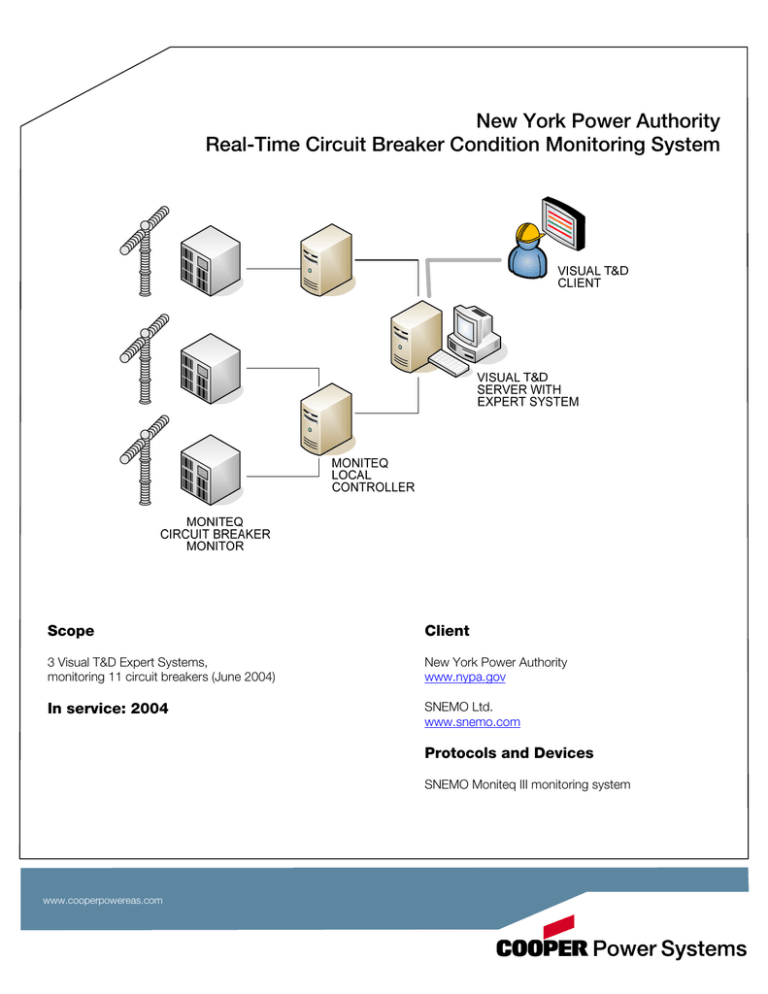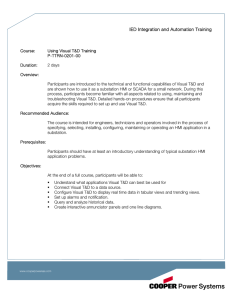
New York Power Authority
Real-Time Circuit Breaker Condition Monitoring System
Scope
Client
3 Visual T&D Expert Systems,
monitoring 11 circuit breakers (June 2004)
New York Power Authority
www.nypa.gov
In service: 2004
SNEMO Ltd.
www.snemo.com
Protocols and Devices
SNEMO Moniteq III monitoring system
www.cooperpowereas.com
The Challenge
The New York Power Authority is America's largest
state-owned power organization. It provides electricity
throughout New York State, operating 17 generating
facilities and more than 1,400 circuit-miles of
transmission lines.
In order to reduce operation and maintenance costs,
the Power Authority has implemented a real-time circuit
breaker condition monitoring system on several breaker
types in critical substations. The data collected from the
monitoring system is used to diagnose the condition of
the breaker and identify abnormalities.
The circuit breaker monitoring system was jointly
developed with Hydro-Quebec's IREQ research center
and is marketed by Snemo, Ltd.
The initial software platform and user interface required
a significant effort to evaluate and analyze the collected
data. It became evident that in order to efficiently
diagnose the condition of the breaker, the operating
platform would require a knowledge-based system
module to process the collected data.
Collaborating with Snemo Ltd., manufacturer of the
MoniTeq III circuit breaker monitoring system, and
Cooper Power Systems., the Power Authority initiated a
project to develop and implement an expert system for
the breaker monitoring system.
The Solution
In order to meet the requirements of the project,
Cooper Power Systems used its Visual T&DTM HMI
software and Cybectec Substation Modernization
PlatformTM (SMP) technology.
Cooper Power Systems’ custom software and
consulting group incorporated a custom
communications module in the MoniTeq Local
Controller. This module, which is based on the protocol
and communication technology used in the
SMP Gateway, supports the exchange of data between
the MoniTeq monitoring device and the Visual T&D HMI.
Quebec City
730 Commerciale Street, Suite 200
Saint-Jean-Chrysostome, Quebec
Canada G6Z 2C5
Technical Support:
P: +1.418.834.0009
support@cybectec.com
Montreal
1290 St. Denis Street, Suite 300
Montreal, Quebec
Canada H2X 3J7
Sales:
P: +1.514.845.6195
sales@cybectec.com
All Cooper logos and Cooper Power Systems are trademarks of Cooper US, Inc., in the U.S. and other countries.
You are not permitted to use Cooper trademarks without the prior written consent of Cooper US, Inc.
©2009 Cooper US, Inc. All Rights Reserved
B1100-09035 • April 2009 • New Issue
Visual T&D was selected since it provides all the
standard SCADA functions: real-time data acquisition,
logging, data display, alarm and event management,
reporting, and historical data analysis.
To diagnose the condition of the circuit breakers,
Cooper Power Systems developed an Expert System
module for Visual T&D. A rule set editor is used to
define the conditions that trigger the evaluation of rules,
as well as the actions to be performed when the rules
apply. The Expert System is completely integrated in
Visual T&D, and the rules can be used to trigger alarms
and events, set data points and send commands to
devices. When specific conditions occur, the Visual
T&D alarm manager can notify users by email or pager.
Based on manufacturer specifications and field
experience, the Power Authority developed rules for
three types of circuit breakers: Westinghouse SF6 SFA
double pressure (345kV and 765kV), GE Hitachi HVB
(345kV), and Cogenel PK air blast circuit breakers.
Cooper Power Systems provided a data simulator to
assist in validating the rules.
When the expert system identifies a potential problem,
it triggers a Visual T&D alarm that contains a description
of the diagnosis found by the expert system. The expert
system also provides a detailed problem description
and suggests possible solutions.
The New York Power Authority has successfully
deployed the system in three substations to monitor
circuit breakers and is now planning to extend the
system to monitor power transformers and batteries.





